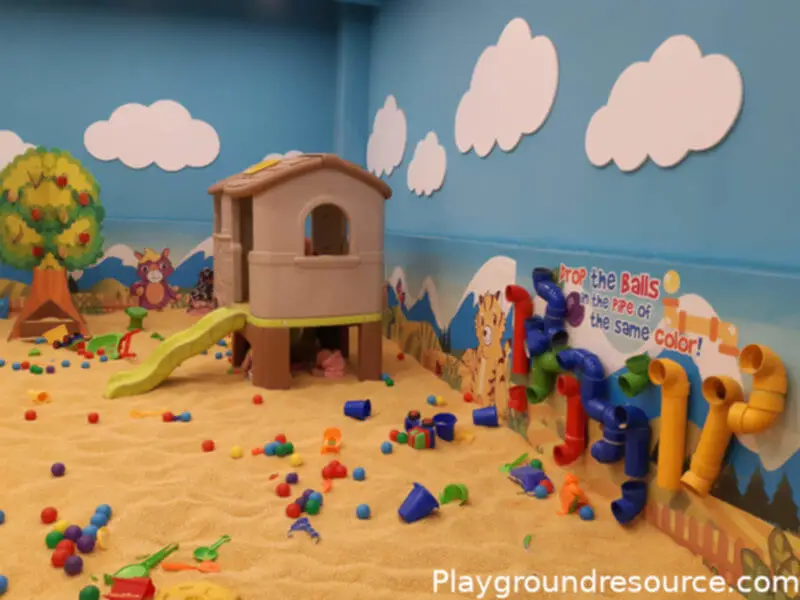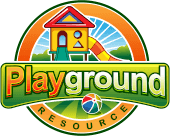
Playground sand can be a breeding ground for bacteria, germs and insects. In this article I’ll show you how to clean and sanitize your playground sand along with ways to keep the bugs out – naturally.
I’ll also share some preventive measures that you can take to ensure your sandbox stays a clean and safe environment, free of harmful bacteria and hazardous materials.
Table of Contents
Cleaning Your Playground Sand
Raking
A fine-tooth rake can be a great tool for cleaning playground sand and removing any larger debris. An easy way is to move all of the sand to one side of your play area then start raking it all back to one side, removing any debris you collect along the way.
After you’re done just smooth it back out. This is a great way to maintain your playground sand and keep it free of foreign objects and debris.
Sifting
Sifting the sand is a sure-fire way to get any and all foreign objects and debris out. A colander is a good tool for this if you have a smaller sandpit, but if you have a large playground area with a lot of sand this can be a tedious and long job indeed.
A more practical way is to do this is with a large sand sieve (Sand Sifter). If you want to keep your playground sand clean or want to clean up a large amount of sand without replacing it all then this is the way to go.
A sand sieve is an inexpensive tool that is a must for anyone who has a sandpit. You can get these plastic sand sifters for cheap on Amazon. It’s also an easy tool to make yourself. Here’s a YouTube video that explains the process well (click here for video).
Sanitize Your Playground Sand
Sanitizing your playground sand and keeping it free of harmful bacteria and fungus is important, especially if your playground area doesn’t get a lot of direct sunlight and/or retains a lot of moisture.
Mold, fungus, mildew, and bacteria can all grow in your playground sand, and to help prevent this potentially harmful growth from occurring it is important to allow your playground sand to dry out.
If the bottom layer of your sandbox stays wet (moist is normal) then rake or shovel the bottom layer to the top, allowing it to dry and consider getting a cover to keep the rain along with other hazards out (I talk more about this later).
A mold called Rhizopus Stolonifer (black bread mold) is notorious for growing in sandboxes and is one of the most common fungi in the world. Most commonly found on the surfaces of bread and fruit this mold usually starts out green or black in color before turning a fluffy gray with black spots.
Chances are you’ve seen this mold growing food that has been left out along with overripe fruit. This mold can be especially dangerous to people with a weakened immune system and can cause a disease named Zygomycosis, which can be fatal.
Rhizopus Stolonifer appears in playground sand most often from animal and bird feces.
White Vinegar Method – How To Sanitize Playground Sand With White Vinegar
White distilled vinegar has been shown to kill 82% of all fungus and will work to kill the fungus on your playground sand.
1. Mix 1 part white distilled vinegar to 1 part water in a pump sprayer.
2. Soak down the top of your playground sand then come through with a rake to mix it around. Repeat the process two or three times letting the vinegar solution remain on top the final time.
3. After this dries (usually an hour or so, depending on sunlight) rake your sandbox again, to ensure proper drying.
This will not only eliminate the mold but will keep cats and other animals out of your sandbox.
Worried about the smell? If you are worried about the strong smell of vinegar, don’t worry, the smell will dissipate naturally when the solution dries. Also, you can add an essential oil (lavender and citrus work well) to the vinegar/water mix to help neutralize the smell.
Also, adding cinnamon to your playground sand after this process will not only help to eliminate the vinegar smell, but will also help to keep bugs out (which we’ll cover move in depth later).
Dealing with the short-lived smell of vinegar is well worth the benefits. A 3-gallon pump sprayer (pictured above) on Amazon is very affordable.
This method is a great all-natural way to not only rid your playground sand of mold and fungus but serves a double purpose as it will keep cats out of your playground sand, who’s feces can be the main spreaders of the Rhizopus Stolonifer fungus along with other harmful bacteria.
Bleach Method – How To Sanitize Playground Sand With Bleach
Bleach will kill 99.9% of germs and bacteria making this method the most effective. Of course, this is not a “natural method”, but for those with sandboxes that are extremely dirty, this can be the best method, second to replacing all of the sand.
If you just purchased a house with an “abandoned” sandbox or your sandbox has been neglected for quite some time this is an alternative to replacing all of the sand.
1. First make sure to rake out any large debris and feces. Consider sifting the sand (see “Cleaning Your Playground Sand” above) and allow it to dry.
2. Mix 1 part bleach to 1 part water in a spray pump.
3. Soak the top layer then rake or shovel to mix in.
4. Repeat this process at least two times, I recommend four.
For the last application, let the bleach solution remain on top until dry (usually about an hour). After this process rake and shove the sand to ensure all of it is dry.
Allow a few days for the sand to completely dry out before allowing anyone to play in it. Follow through with the methods I list below for Keeping Bugs Out and Keeping Your Playground Sand Clean and Safe to ensure you maintain a safe and clean playground area.
Keep Bugs Out Of Your Playground Sand
Insects such as fleas, ticks, and worms are common trespassers in playground sand. They can carry disease and can make your sandbox uninhabitable by you and your children.
Parasitic worms can also post a serious threat and most often come from animal and bird feces.
Cinnamon Method – How To Keep Bugs Out Of Playground Sand With Cinnamon
The Cinnamon method is very popular, and for good reason. I recommend spreading about a pound of ground cinnamon (for a 6 foot squared to 9 foot squared sandbox) into your playground sand and raking it in to mix.
Cinnamon is a natural and safe insect repellent and will make your sandbox smell great. I especially advise using cinnamon if you’re having mold issues and used the vinegar method I mentioned above to kill the mold.
The bottom line is that cinnamon really is a great natural insect repellent and very inexpensive! A 1 pound bag of organic cinnamon on Amazon (pictured below) is very affordable making it well worth it.
Diatomaceous Earth Method – How To Keep Bugs Out Of Playground Sand With DE
Diatomaceous Earth is the ground up, fossilized remains of aquatic organisms called Diatoms. The diatom’s skeleton is made of the natural substance Silica.
Spreading the powder around the parameter of your sandbox will naturally kill bugs and insects of all kinds. Diatomaceous Earth is not toxic or harmful to humans and pets unless inhaled. That is why I recommend putting this natural substance around the parameter of your sandbox and not in the sand.
Diatomaceous Earth is used in 1,000s of products including pesticides, skincare products, toothpaste, foods, beverages and lots more.
This natural substance will kill cockroaches, bedbugs, fleas, ticks, spiders, ants and many more.
It is often advertised as “the insect replant you can eat“, and we do eat it because most grains and raw foods which are stored have Diatomaceous Earth mixed in to keep the insects out.
It’s an inexpensive, safe product that has many other uses, you can get a 10-pound food grade bag of Diatomaceous Earth (pictured below) on Amazon.
Keeping Your Playground Sand Clean and Safe
A Cover for Your Sandbox is going to be the best way to keep it clean and free of harmful and hazardous materials, especially if you live in an area with a lot of roaming animals and pets.
One downside to this is that the sand will not be able to dry out as well, but if you allow the sand to dry completely before you start using the cover, you’ll be fine.
They make covers specifically for sandboxes that have a drawstring to secure the tarp over the parameter of the sandbox and are available in a few different sizes. Here’s a 6′ x 6′ and 9′ x 9′ drawstring tarp on Amazon.
Or you can go with a regular outdoor tarp (both products are basically the same thing) here’s a lightweight waterproof outdoor tarp on Amazon that’s available in 5′ x 5′ and 7′ x 7′ sizes.
- Regularly Rake Your Playground Sand. This will remove any large debris, create an unfriendly environment for insects and fungus and also help the sand to dry, which is important for the overall “health” of your sand.
Also consider getting a sand sifter, they are very affordable and you can even make your own.
- Repel Insects Naturally. Use the methods I mentioned above to keep harmful and potentially disease-carrying insects out of your playground sand. Even the best tarp or cover will not keep these tiny creatures out.
Using the two methods I mentioned above are a safe, natural and affordable way to keep the critters out of your child’s sandbox. It only takes a few minutes to take these measures and will pay off.
Final Thoughts and Considerations
Man-made sandboxes have been around since the late 1800s. They make a great, natural environment for your child to play in, providing many different creative activities.
It’s important to keep your sand clean and free of any debris or other harmful materials.
There are other playground ground cover materials available that can be just as affordable, durable and as easy to install as playground sand. If want to explore these options please check out my article titled “Backyard Playground Ground Cover – 5 Best Materials to DIY“.
Related Questions
How Do I Dispose of Playbox Sand?
- Use the sand to fill in holes or low spots in your yard
- Use the sand for potted plants or in your garden. Many plants and vegetables need sandy soil for drainage.
- Use the sand in your garage or driveway to soak up oil
- Bury the sand or dump into a creek or pond.
Can Playground Sand Go Bad?
Playground sand can lose its course texture over time, becoming “dusty” which can lead to health problems if your child inhales this dust over time.


